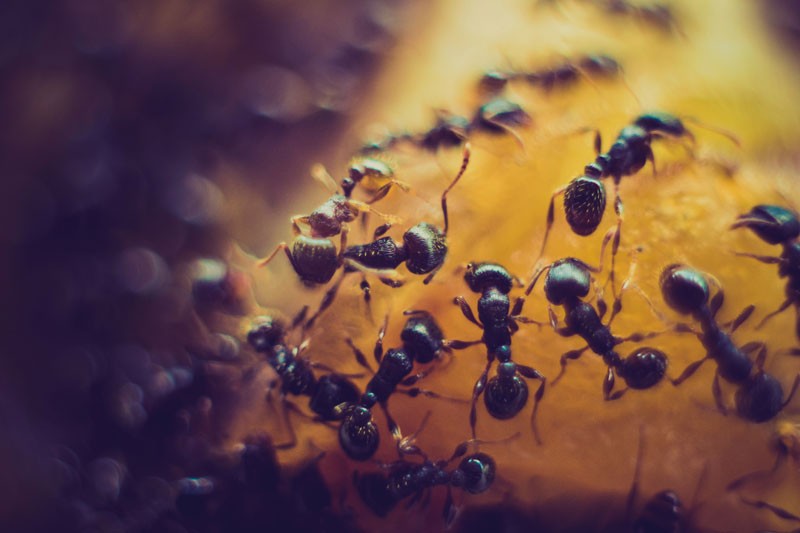
How to tell the difference between ant species in Australia
There are at least 1,275 known species of ants in Australia, but only a few are considered as household pests. It’s handy to know which species you’re dealing with in the event of an outbreak, as this can affect the type of treatment you’ll need to manage them for good.
If you’re experiencing an ant outbreak and wondering which type of ant is the cause, we’ve prepared this guide on identifying the most common pest ants.
What questions will this article answer?
Importance of Identifying Australian Ants
While most ant outbreaks can be easily treated, certain ants, due to their behavior, require more targeted or aggressive solutions.
For example, some species, like Pharaoh and Argentine ants, can multiply fast and create several nests, requiring long-term treatment to prevent sustained attacks. On the other hand, bull ants are known for their painful bites, and carpenter ants build their nests in wooden house frames, so you’ll want to prevent an outbreak quickly.
However, without special training, it can be challenging to identify which species of ant is causing problems around your home or business.
The earlier you determine which species of ant is the culprit, the faster the outbreak can be treated, and any potential damage and disruption can be minimised. That’s where professional pest control can make a big difference.
Get effective ant removal advice today
 or
or
Black House Ant
Quite possibly the most common type of ant that you’ll encounter, black house ants often lurk around kitchens, bathrooms and even your garage.
They are 2.5-3mm long and shiny black coloured, with 6 spindly legs.
Black house ant larvae normally take over 6 weeks to mature into adults.
They feed on sweet and greasy food, breadcrumbs and meat.
Fire Ant
As aggressive defenders of their nests, fire ants aren’t afraid to sting to defend their colony if provoked. These painful stings can swell into welts within 24-48 hours and trigger allergic reactions.
They build distinct nest mounds which can stand over 40cm high above their underground chambers.
Fire ants have a characteristic antennae club, bright copper head and dark brown body. Workers grow between 3.18-6.15mm and queens are 1.59cm long.
Larvae take 16 days to mature.
They feast on dead insects, vertebrates and earthworms, as well as sweets, fatty food and proteins.
Ghost Ant
Drawn to areas with high moisture, such as kitchen and bathrooms, ghost ants nest in wall spaces, loose bark, flowerpots and underneath objects in the ground. A single colony can have several nesting sites.
They have pale, translucent legs and abdomens and grow up to 1.6mm long.
Ghost ants eat sweet and greasy food, as well as honeydew produced from aphids.
Prevent ants fast. Speak to an expert today.
 or
or
Odorous House Ant
Producing a unique coconut smell when crushed, odorous house ants are attracted to places with moisture. However, you’ll also find them lurking around house plants and toilet lids.
They are usually brown or black in colour with 6 legs and antennae with 12 segments.
Odorous house ants grow between 1.59-3.18mm long and take 34-38 days to become adults.
They feed on pet food, sweet foods and fruits, particularly melons.
Pharoah’s Ant
Most commonly found in heating systems and areas with humidity, Pharaoh’s ants swarm all year long and are often found in hospitals. They form new colonies after their nests have been disturbed from insecticide treatments.
Pharaoh’s ants have black eyes and 2 small segments at the pedicel. Workers are yellow/brown with brown abdomen and grow up to 1.5-2mm long. Males have wings and are usually black and 3mm long. Queens are dark red and also have wings, and typically measure 3.5-6mm long.
Larvae take 18-20 days to mature into adults.
Their favourite foods are high in protein, such as meat, blood, fat and dead insects.
Carpenter Ant
With their strong jaws, carpenter ants chew through wooden structures and objects, leaving behind wood shavings, also known as frass. They can cause significant structural damage to buildings and trees, and build satellite nests in different areas.
Carpenter ants are usually dark brown, orange or black coloured, with 6 legs and 2 antennae. They range from 3-12mm long, depending on their job classification within the colony.
Workers take 60 days to become adults.
They enjoy feeding on honeydew produced by aphids, dead insects and pantry food items.
Argentine Ant
A well-known ecological pest, Argentine ants are aggressive and territorial, and will deter other native ant species from setting up a colony in their preferred area. They also attack nesting birds and hatching eggs. You’ll find their nests in wood, tree cavities, older shrubs and mulch.
Argentine ants are light to dark brown in colour, with a small and slender build. They grow 2.2-2.6mm long.
Their diet includes sweets, decaying fruit, cereal, meat products as well as insects.
Bull Ant
If you’ve disturbed a bull ant nest, watch out! They can be very aggressive and secrete venom through their painful bites. With excellent eyesight, they prefer to hide away in areas with dense vegetation, nesting under logs and rocks.
They are red to black coloured and can grow up to 40mm in size. Eggs take 3-4 months hatch and mature into adults.
They collect plant nectar and other plant juices as well as animal prey.
Professional ant extermination
Then, we’ll come up with a treatment plan, which typically involves a combination of the following methods:
Ant control dust
When sprinkled into wall cavities and roof voids and other hard-to-reach areas, this kills ants upon contact.
Insecticide
Applied to treated zones around the perimeter of the building, this acts as an effective deterrent for ants attempting to enter.
Chemical baits
We’ll strategically position baiting stations at popular feeding sites to ensure that as many ants as possible can carry the poisonous bait back to the colony.
Ant prevention treatment can usually take time before seeing results, so your technician will need to return to replenish it and review its effectiveness after a few weeks.
For effective and reliable ant removal, choose Allstate
At Allstate pest control, our technicians are highly trained to identify different types of ant species that require specific treatment modalities. This means that you won’t need to worry about getting to the root cause of the outbreak yourself, and you can expect that it will be treated as quickly as possible.
We’re available 24/7 to all suburbs of Adelaide to treat infestations in residential, commercial and industrial settings. Using modern technology and innovative treatments that are safe for people, pets and the environment, we offer a 100% satisfaction guarantee and competitive warranties on all our services.
With payment plans available, there is no need to delay having an ant extermination through Allstate.
Our expert team is ready to help you now
 or
or
Frequently Asked Questions
What are the most common ants found in Australian homes?
Argentine, blackhouse, and ghost ants are Australia’s most common ant varieties. These nuisance pests are attracted to sweet foods, pet food, and other insects and often build nesting sites in wall spaces or soil near foundations.
How can I identify a bull ant in my backyard?
Bull ants are a native ant species known for their powerful sting and aggressive nature. They have distinct reddish-brown bodies, large mandibles, and painful bites. Bull ants are found near trees, plants, or nest mounds in urban and rural areas.
Are carpenter ants dangerous to my house structure?
Carpenter ants can cause significant damage by hollowing wooden structures for nesting sites. Although they don’t consume wood, their presence is marked by smooth tunnels, frass, or disturbed wooden surfaces.
What eco-friendly methods can I use to manage ghost ants?
To manage ghost ants and other ant species, use natural repellents like vinegar sprays, lemon juice, or essential oils such as peppermint. Ensure cleanliness to prevent attraction to honeydew produced by aphids, sweet foods, or dead insects. Seal entry points near wall spaces and heating systems to prevent invasive ants like Pharaoh’s ants from creating new colonies.
When should I call a professional pest control service for ants?
Call a pest control service if ants like fire ants or coastal brown ants build super colonies or if invasive ant species cause structural damage. Licensed experts can treat commercial buildings, homes, and urban areas infestations, particularly when colonies with multiple queens or satellite nests are involved.



